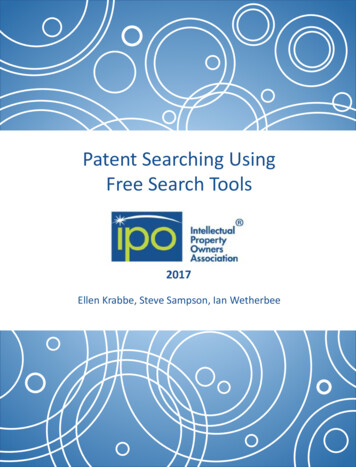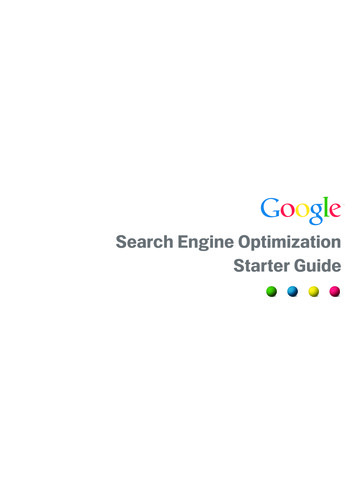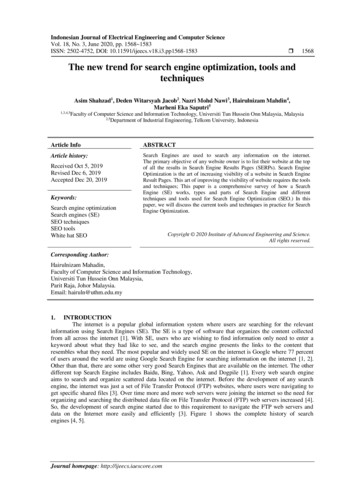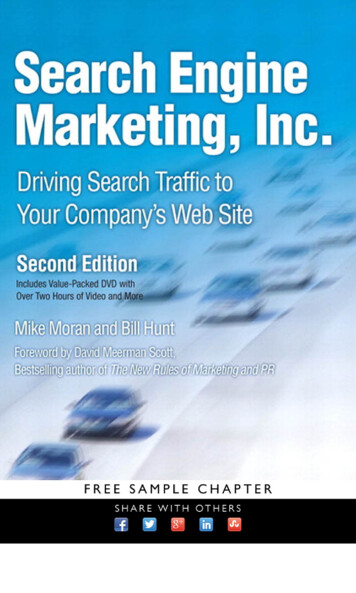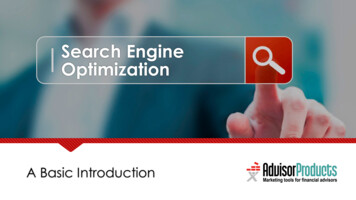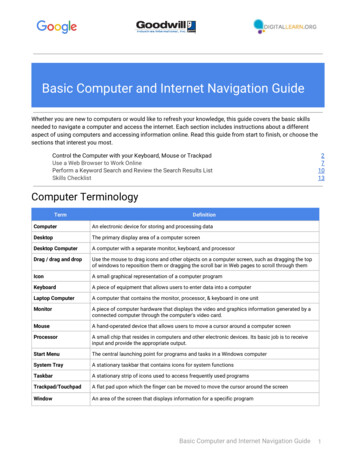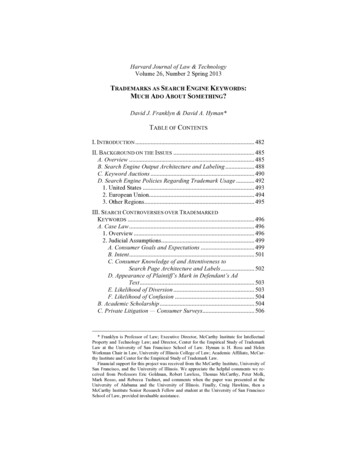
Transcription
Harvard Journal of Law & TechnologyVolume 26, Number 2 Spring 2013TRADEMARKS AS SEARCH ENGINE KEYWORDS:MUCH ADO ABOUT SOMETHING?David J. Franklyn & David A. Hyman*TABLE OF CONTENTSI. INTRODUCTION . 482II. BACKGROUND ON THE ISSUES . 485A. Overview . 485B. Search Engine Output Architecture and Labeling . 488C. Keyword Auctions . 490D. Search Engine Policies Regarding Trademark Usage . 4921. United States . 4932. European Union. 4943. Other Regions . 495III. SEARCH CONTROVERSIES OVER TRADEMARKEDKEYWORDS . 496A. Case Law . 4961. Overview . 4962. Judicial Assumptions. 499A. Consumer Goals and Expectations . 499B. Intent . 501C. Consumer Knowledge of and Attentiveness toSearch Page Architecture and Labels . 502D. Appearance of Plaintiff’s Mark in Defendant’s AdText . 503E. Likelihood of Diversion . 503F. Likelihood of Confusion . 504B. Academic Scholarship . 504C. Private Litigation — Consumer Surveys. 506* Franklyn is Professor of Law; Executive Director, McCarthy Institute for IntellectualProperty and Technology Law; and Director, Center for the Empirical Study of TrademarkLaw at the University of San Francisco School of Law. Hyman is H. Ross and HelenWorkman Chair in Law, University of Illinois College of Law; Academic Affiliate, McCarthy Institute and Center for the Empirical Study of Trademark Law.Financial support for this project was received from the McCarthy Institute, University ofSan Francisco, and the University of Illinois. We appreciate the helpful comments we received from Professors Eric Goldman, Robert Lawless, Thomas McCarthy, Peter Molk,Mark Rosso, and Rebecca Tushnet, and comments when the paper was presented at theUniversity of Alabama and the University of Illinois. Finally, Craig Hawkins, then aMcCarthy Institute Senior Research Fellow and student at the University of San FranciscoSchool of Law, provided invaluable assistance.
482Harvard Journal of Law & Technology[Vol. 26IV. EMPIRICAL FINDINGS . 510A. Coding Study . 510B. Surveys . 5111. Overview . 5112. Background on Surveys . 512A. 1st Survey . 512B. 2nd Survey . 512C. 3rd Survey . 5123. Survey Findings. 513A. Consumer Knowledge of Search Page Architecture . 513B. Adequacy of Disclosure of Paid Links . 515C. Consumer Preferences and Expectations. 517D. Consumer Attentiveness to Search PageArchitecture and Labels . 518E. Paid Link Click-Through . 520F. Diversion and Confusion . 523G. Fairness Norms . 526H. Regression Analysis . 527V. DISCUSSION . 527A. Limitations of Our Findings . 527B. Framing of the Trademarks as Keywords Debate . 528C. Search Page Architecture and Labels. 529D. Trademark Inclusion in Ad Text . 530E. Intent . 531F. Diversion . 532G. Likelihood of Confusion . 533H. Survey Complexities. 536I. Whither Trademark Law: Confusion, Free-Riding, orBoth? . 538J. The Perils of Casual Empiricism . 540K. What is Really at Stake? . 540VI. CONCLUSION . 541APPENDIX ONE: TABLES. 543I. INTRODUCTIONGoogle, Bing, and Yahoo are the primary gateways to the Internet1for most people in the United States. Google is worth more than 2601. Brad Stone, Sure, It’s Big. But Is That Bad?, N.Y. TIMES, May 23, 2010, at BU1; seealso Benjamin G. Edelman, Google’s Dominance — And What To Do About It, ACSBLOG(Oct. 3, 2011), inance-%E2%80%93-and-what-to-do-about-it.
No. 2]Trademarks as Keywords4832billion, and Yahoo is worth more than 25 billion. These lofty market capitalizations are almost entirely attributable to the income gen3erated by the advertising that accompanies search results.Most searches result in one or more paid ads appearing alongsidethe unpaid (organic or algorithmic) results. The specific ads that appear are selected because they relate to the search terms (“keywords”)entered by the user. For example, a search for “bicycle” will returnads from stores and websites selling bikes as well as bike manufacturers. A search for “wedding” will return ads from stores and websitesselling wedding supplies, wedding dresses, and wedding cakes. Asearch for “mesothelioma” will return ads from plaintiffs’ attorneys.Each of these entities pays the search engine if its ad is clicked on,4irrespective of whether a sale is ultimately made.When search engines began offering ads using trademarks askeywords, disgruntled trademark owners filed more than one hundred5lawsuits in the United States and Europe. Despite the volume of litigation, there has been little independent empirical work on consumergoals and expectations when using trademarks as search terms, onwhether consumers are actually confused by search results, and onwhich entities are buying trademarks as keywords. Instead, judgeshave relied heavily on their own intuitions, based on little more thanarmchair empiricism, to resolve such matters.We report on the results of a two-part study, including threeonline consumer surveys and a coding study of the results when 2500trademarks were run through three search engines. Consumer goalsand expectations turn out to be quite heterogeneous: a majority ofconsumers use brand names to search primarily for the branded goods,2. Google Inc. Stock Quote & Summary Data, NASDAQ, http://www.nasdaq.com/symbol/goog (last visited May 9, 2013); Yahoo! Inc. Stock Quote & Summary Data,NASDAQ, http://www.nasdaq.com/symbol/yhoo (last visited May 9, 2013). It is difficult toput a value on Bing, since it is part of Microsoft, but one set of analysts estimated it wasworth about 11 billion. Robert Cyran & Martin Hutchinson, At Microsoft, Bing Too Costlyto Keep, N.Y. TIMES, July 25, 2011, at B2.3. Advertising revenue made up 97% of Google’s first quarter revenues in 2011. GoogleInc., Quarterly Report (Form 10-Q), at 27 (Apr. 25, 2012), available athttp://investor.google.com/pdf/20120331 google 10Q.pdf. For Yahoo, the figure is 80%.Yahoo Inc., Quarterly Report (Form 10-Q), at 37 (May 9, 2012), available 254543x0xS1193125-11-134295/1011006/filing.pdf; see also Steven Levy, Secret of Googlenomics: Data-Fueled RecipeBrews Profitability, WIRED (May 22, 2009), ne/17-06/nep googlenomics (quoting then-Google CEO Eric Schmidtthat after the implementation of a new version of AdWords, “[a]ll of a sudden we realizedwe were in the auction business”).4. See Cost-Per-Click Bidding, GOOGLE, http://support.google.com/adwords/bin/answer.py?hl en&answer 2464960&topic 1713914&path 1713956-1713909&ctx leftnav(last visited May 9, 2013).5. A list of the filed cases we have been able to identify as of June 2012 is available fromthe authors on request.
484Harvard Journal of Law & Technology[Vol. 266but most consumers are open to purchasing competing products. Wefind little evidence of traditional actionable consumer confusion regarding the source of goods, but only a small minority of consumerscorrectly and consistently distinguished paid ads from unpaid searchresults,7 or noticed the labels that search engines use to differentiate8paid ads from unpaid search results.We also find that the aggregate risk of consumer confusion islow, because most of the ads triggered by the use of trademarks askeywords are for authorized sellers or the trademark owners them9selves. Perhaps our most intriguing finding is the sizeable mismatchbetween consumer sentiments and the protections provided by U.S.trademark law. After we excluded those who were unsure or had noopinion, survey respondents were evenly split on whether it was fairand appropriate for competitors to purchase one another’s trademarksfor use as keywords, even without any confusion as to source, spon10sorship, or affiliation. These findings may explain why Europeantrademark law recognizes a cause of action for taking unfair advantage of a trademark.11 Although the law need not precisely matchcommon moral intuitions, our findings suggest that it may be desirable to create a similar cause of action under U.S. trademark law.Although we do find some evidence of confusion, the types ofconfusion we document do not map neatly onto the categories recognized by U.S. trademark law. Our findings suggest that the development of the doctrine in this area has not been well served by thereliance of judges on casual empiricism in resolving these disputes.6. See infra Table 6.7. See infra Table 4, Panel B.8. See infra Table 7.9. See infra Table 2.10. For two of the three ads, approximately 53% of those who had an opinion thought itwas not fair and appropriate. For the third ad, 42% of those who had an opinion thought itwas not fair and appropriate. For each ad, 25% of those responding did not have an opinion.See infra Table 13.11. A European Union directive protects trademark owners from taking unfair advantageof the distinctive character of a registered mark. See generally Council Directive 89/104, art.5, 1988 O.J. (L 40) (EU). This prohibition allows a trademark owner to stop others fromusing marks that are identical or similar to the registered mark when doing so “takes unfairadvantage of, or is detrimental to, the distinctive character or the repute of the trade mark.”Id. at 6–7. An advertiser takes unfair advantage when they select a keyword that is similaror identical to an established trademark, “in order to benefit from the power of attraction,the reputation and the prestige of that mark and to exploit, without paying any financialcompensation, the marketing effort expended by the proprietor of the mark in order to createand maintain the mark’s image.” L’Oréal SA v. Bellure NV, Case C-487/07, para 50, 2009ECJ EUR-Lex LEXIS 532 (June 18, 2009).However, if an advertiser that selects a reputable trademark as a keyword is only doing soto present an alternative to the trademark owner’s goods or services, that use is fair competition as long as the advertiser does not blur, tarnish, or adversely affect the primary trademark. Interflora Inc., Interflora British Unit v. Marks & Spencer plc, Flowers Direct OnlineLtd., Case C-323/09, 2011 ECJ EUR-Lex LEXIS 2120 (Sept. 22, 2011).
No. 2]Trademarks as Keywords485Much remains to be done to ensure that trademark doctrine is empirically well-grounded, and “fits” the online context.Part II provides some context for this dispute, including background on search engines and keyword searches. Part III outlines theextensive litigation, both foreign and domestic, over the use of trademarks as keywords, and identifies six assumptions that judges havemade in resolving these cases. Part IV presents our empirical results.Part V discusses our findings, and Part VI concludes.II. BACKGROUND ON THE ISSUESA. OverviewIn 2004, Google started selling keywords that were also trade12marks. Conflict quickly arose. The problem is straightforward. If Irun a search for American Airlines, and Delta Airlines appears in apaid ad on the search output page because Delta Airlines purchased“American Airlines” as a keyword, does American Airlines have anyrecourse? If so, against whom? Google? Delta Airlines? Both? Neither? What if Travelocity, which sells flights on both American Airlines and Delta Airlines, appears in a paid ad? Should the outcometurn on whether the paid ad uses the words “American Airlines” in thead text?Trademark law is primarily intended to prevent confusion aboutthe origins of trademarked goods and services, but is it plausible that aconsumer who searches for American Airlines and then buys a ticketon Delta Airlines was ever confused about which carrier he will beflying on? Even if the consumer is not confused about the airline heultimately selects, should diversion of attention, however temporary,create a cause of action?Should the mode or level of trade make any difference in theanalysis? For example, searchers can obtain a reservation for a roomat a Hyatt hotel either directly from Hyatt’s website or from a travelwebsite (e.g., Orbitz, Travelocity, getaroom.com, etc.). Hyatt makesmore money if searchers deal directly with them, instead of going13through a travel website. Does Hyatt have a valid complaint if travel12. See infra Part II.C. Earlier disputes had involved the use of trademarks as domainnames and metatags. Dan L. Burk, Cybermarks, 94 MINN. L. REV. 1375, 1376–81 (2010).13. See Peter M. Ripin, Keyword Confusion, HOSPITALITY.NET (May 1, tml (noting that hotels “have to pay a commission of approximately 18–30% to the online travel agency,” and “[s]ince a hotel’s ownbranded Website produces the highest average daily rate, it is clearly in the hotel’s bestinterest to drive Internet business to its own site rather than to an online travel agent”). Seealso Jane L. Levere, American Airlines in Fee Battle with Web Agencies, N.Y. TIMES, Jan.5, 2011, at B1 (noting that “to sell an average, round-trip domestic ticket, American mustpay 10 to 12, for global distribution and agency incentive fees, on online agency book-
486Harvard Journal of Law & Technology[Vol. 26websites purchase the Hyatt trademark as a keyword? Should the outcome turn on where consumers ultimately make reservations aftersearching for “Hyatt”? Does the fact that Hyatt makes less money ifreservations are made through travel websites have any legal significance?Of course, Hyatt can capture some of these reservations if it bidson its own trademark, but should Hyatt have to pay for the use of a14trademark it already owns? Hyatt could prohibit travel websites withwhich it does business from purchasing its trademark as a keyword,but that would leave the field open to its competitors to buy higher15placement for their ads.What if someone searches for Rolex, and three ads come up: onefor Seiko, one for a seller of counterfeit Rolexes, and one for a storeings, while it costs the carrier only 2 to 3 — for administrative and marketing expenses —to sell the same ticket on its own Web site”).Early on, companies used pop-up ads to try to divert traffic from competitors. Peter M.Ripin, Hotel Internet Marketers Beware: Pop-up and Keyword Advertising Threaten YourOn-line Brand, WIREDHOTELIER.COM (Oct. 26, 2004), http://www.wiredhotelier.com/news//4021026.html. One commenter at the time noted a prominent example:[A] recently published report stated that a number of our most prominent companies were now using popup ads to target their competitors’ websites including Best Western whose ads appeared on 208other sites including those of Comfort Inn and Day’s Inn; ThriftyRent A Car whose ads were aimed at Dollar-Rent-A-Car and Enterprise Rent-A-Car and Verizon DSL whose ads were triggered by visits to the sites of broadband provider competitors.Id.14. See Scott Cleland, Google 21st Century Robber Baron, FORBES (Sept. 19, 1/09/19/google-21st-century-robber-baron(“Google shortchanges trademark owners by forcing them to buy their own trademark property as keyword advertising in order to protect their businesses from Google selling theirtrademarks to competitors. In the physical world this scheme is known as a ‘protectionracket.’”). Trademark owners have made similar complaints about the Internet Corporationfor Assigned Names and Numbers’ addition of new top-level domains. Dennis S. Prahl &Eric Null, The New Generic Top-Level Domain Program: A New Era of Risk for TrademarkOwners and the Internet, 101 TRADEMARK REP. 1757, 1759 (2011).15. Cf. Johanna Jainchill, Carnival Brands’ Keyword Rule Gives Rivals a Boost, TRAVELWKLY. (Jan. 31, 2010), -brands’keyword-rule-gives-rivals-a-boost (describing a similar situation after cruise lines restrictedtravel agencies from using their trademarks). An observer noted the greater prominence ofrival sites once the travel agencies ceased advertising:Carnival Corp. brands’ decision to prohibit travel agencies from bidding on their trademarks as keywords in online search engines led towhat would seem to be an unintended consequence: a higher placement for the sponsored links of competing cruise lines . . . . “Itdoesn’t make sense that Carnival would prefer to have their competition’s website right up at the top of the search results, instead of people who actually sell Carnival cruises . . . .”Id. (quoting an anonymous cruise seller and former Carnival keyword bidder).Marriott and Intercontinental Hotels have also prohibited online travel agencies frombidding on their trademarks. Five Cruise Lines Ban Agencies from Bidding on Keywords,AIR TRANSPORT WORLD (Jan. 6, 2010), se-lines-ban-agencies-bidding-keywords-0309-0.
No. 2]Trademarks as Keywords487selling genuine Rolex and Seiko watches. Does Rolex have a caseagainst any or all of them? If Rolex has a case, what needs to be established? Does the bare fact that a competitor or counterfeiter purchased another company’s trademark as a keyword establish thenecessary elements of trademark infringement? Are there any defenses available to those who purchased a trademark to use as a keyword,and to the search engine that sold it? Does it matter if the resulting adis simply comparative? For example, “our watches have the same design features as a Rolex, but cost less.” Does it matter that the storesells both Rolex and Seiko watches? Does it matter if the individualwho conducted the search was using Rolex as a generic proxy termfor “expensive watches”?These questions are not law school hypotheticals. In well overone hundred cases in U.S. and foreign courts, disgruntled trademarkowners have sued Google and other search engines, as well as the en16tities that have purchased trademarks as keywords. Courts have varied in their approaches to these cases, in many instances showing17considerable skepticism about the merits, while in other instancesexpanding the law to include conduct outside the traditional ambit of18trademark doctrine. Judges in both camps have routinely engaged inarmchair empiricism, making casual assumptions about such mattersas why consumers use trademarks as search terms, consumerknowledge about the difference between paid and unpaid links, andthe likelihood of confusion when competitors purchase one another’strademarks for use as search engine keywords.19The sale of search engine keywords, whether trademarked or not,also raises interesting consumer protection issues. As noted previously, a search engine typically returns both paid and unpaid results.Consumer protection law requires a “clear and conspicuous” disclo16. See supra note 5.17. See, e.g., J.G. Wentworth, S.S.C. LP v. Settlement Funding LLC, 85 U.S.P.Q.2d1780, 1786 (E.D. Pa. 2007); Designer Skin, LLC v. S & L Vitamins, Inc., 560 F. Supp. 2d811, 818–19 (D. Ariz. 2008).18. See, e.g., Storus Corp. v. Aroa Mktg. Inc., 87 U.S.P.Q.2d 1032, 1035–36 (N.D. Cal.2008) (noting that the infringing act in the Internet context is diversion of consumers evenwhere consumers know they are not going to plaintiff’s site because the defendant improperly benefits from the owner’s goodwill); Partners for Health and Home, LP v. Yang, 98U.S.P.Q.2d 1462, 1467 (C.D. Cal. 2010) (stating that actual confusion is not needed to findinitial interest confusion since initial interest confusion is based on defendant’s misappropriation of plaintiff’s goodwill); Partners for Health and Home, L.P. v. Yang, No. CV 0907849-RZ, 2011 U.S. Dist. LEXIS 130921, at *17 (C.D. Cal. Oct. 28, 2011) (holding thatuse of a competitor’s trademark as a keyword constitutes infringement absent circumstancesnegating confusion); Austl. Gold, Inc. v. Hatfield, 436 F.3d 1228, 1238 (10th Cir. 2006)(“Initial interest confusion results when a consumer seeks a particular trademark holder’sproduct and instead is lured to the product of a competitor by the competitor’s use of thesame or a similar mark.”).19. For discussion of six specific types of judicial armchair empiricism, see infra PartIII.A.2.
488Harvard Journal of Law & Technology[Vol. 2620sure of paid content. Are search engines complying with these requirements? How have search engines changed their descriptions ofpaid content over time? Do changes made by search engines result ingreater awareness of the difference between paid and unpaid content?Do these changes affect click-through behavior? The Federal TradeCommission has expressed concern about the labeling and page architecture of search engine results, but has not brought any cases to21date.We focus on Google in this Article because it is the dominantsearch engine. However, where appropriate, we describe differencesin the way in which Google, Bing, and Yahoo present and label searchresults.B. Search Engine Output Architecture and LabelingWe are confident that every reader of this Article has a generalunderstanding of how Google organizes its search output. However,for those happy few who have no knowledge of Google’s search pagearchitecture, but for some reason have chosen to read this Article,Figure 1 is a screenshot of the results when “Mercedes” was used as a22search term in 2011.20. See generally FED. TRADE COMM’N, DOT COM DISCLOSURES: INFORMATION ABOUTONLINE ADVERTISING (2000), available at closures-information-about-online-advertising.21. See Letter from Heather Hippsley, Acting Assoc. Dir., Div. of Adver. Practices, Fed.Trade Comm’n, to Gary Ruskin, Exec. Dir., Commercial Alert (June 27, 2002), available lertletter.shtm. In 2013, Google agreed tochange some of its business practices in response to FTC concerns, but the labeling of itssearch results was not part of the settlement. Press Release, Fed. Trade Comm’n, GoogleAgrees to Change Its Business Practices to Resolve FTC Competition Concerns in the Markets for Devices Like Smart Phones, Games and Tablets, and in Online Search (Jan. 3,2013), available at http://www.ftc.gov/opa/2013/01/google.shtm.22. This screenshot was captured on December 16, 2011 and used as part of the third survey, as described below. We have modified the image so that it is easier to see the differentregions of the search output.After research for this Article was completed, Google revised the architecture of itssearch output page and created a new “Google Shopping” section. Sameer Samat, Buildinga Better Shopping Experience, GOOGLE COM. BLOG (May 31, 2012), g-better-shopping-experience.html. The newsection, which appears under either Section 1 or Section 2 in Figure 1, is labeled “Sponsored.” Id. Thus, Google is simultaneously using the terms “Ads” and “Sponsored” to referto paid content. The impact of these changes on consumer perceptions is the subject of anongoing empirical study.
No. 2]Trademarks as Keywords489Figure 1: Google Search of “Mercedes”As Figure 1 reflects, Google’s search output from 2011 has several discrete sections. At the top of the page is a small search box, withlinks to various types of search output (e.g., web, images, videos,maps, news, shopping, mail, and “more”). To the left, a column largely replicates the links in the top zone, along with links to change theregion that Google uses as the search location, and a tool with whichto specify the time period searched. Below and to the right are threesections containing search information. The shaded top section, Sec-
490Harvard Journal of Law & Technology[Vol. 26tion A, contains various search results and associated links, which are23labeled “Ads.” The right-hand column, Section B, contains moresearch results and associated links, and is labeled “Ads” as well,though the background is not shaded. Finally, underneath Section Aand to the left of Section B is Section C, with more search results andassociated links.The links in Section A and Section B are all paid ads. Each linkthat appears in these areas of the search results page is there becausethe relevant site won the right to appear by bidding in an auction ofkeywords run by Google.24 Conversely, the links in Section C areunpaid “organic” or “algorithmic” content, which appear as a result of25Google’s search program.Bing labels its paid links using the same terminology (“Ads”) and26the same search page architecture. Yahoo labels paid links with theterm “Sponsored Results” but uses the same search page architectureas Bing.27Prior to November 2010, Google labeled paid links as “Sponsored28Links.” Prior to April 2011, Bing labeled paid links as “Sponsored29Sites.” Other search engines have used a wide array of labels toidentify paid links at one time or another, including “Featured Listings,” “Premier Listings,” “Recommended Sites,” “Search Partners,”30and “Spotlight.”C. Keyword AuctionsGoogle began AdWords, a program of selling ads based on spe31cific keywords, in 2000. AdWords took its current payment-per23. As Professor Benjamin Edelman has pointed out, the label “Ads” is so small that italmost fits inside the “O” in the Google masthead. A Closer Look at Google’s AdvertisementLabels, BENEDELMAN.ORG (Nov. 10, 2010), 0.html.24. We describe the keyword auction in greater detail infra Part II.C.25. Google is increasingly trying to customize its results, so the reference to “algorithmic” search is an oversimplification. For an alternative formulation of Google’s searchmethodology, see Our Search: Google Technology, GOOGLE (Apr. 1, gy/pigeonrank.html.26. Benjamin Edelman & Duncan J. Gilchrist, Advertising Disclosures: Measuring Labeling Alternatives in Internet Search Engines 6, 14 (Harvard Bus. Sch., Working Paper No.11-048, 2012), available at http://papers.ssrn.com/sol3/papers.cfm?abstract id 1706121.27. Id.28. Barry Schwartz, Google Does Away with “Sponsored Links” Label, Now Ads AreLabeled “Ads,” SEARCH ENGINE LAND (Nov. 5, 2010, 3:06 PM), sponsored-links-label-now-ads-are-labeledads-54956 [hereinafter Schwartz, Google Does Away with “Sponsored Links”].29. Edelman & Gilchrist, supra note 26, at 6.30. See Hippsley, supra note 21.31. Press Release, Google, Google Launches Self-Service Advertising Program (Oct. 23,2000), 9.html.
No. 2]Trademarks as Keywords49132click form in 2002. In 2004, Google eliminated many restrictions onthe use of trademarks as keywords.33 We discuss below the circumstances under which trademarks may be included in ad text.Individuals and entities bid to have their ad appear when specified34keywords are used as search terms. Whether a particular ad appearsdepends on various factors, including the details of the search query,the amount that is bid, past performance of the ad in the context ofsuch searches (i.e., click-through rates), and whether and how the bid35is limited by the bidder. For example, bidders can target their
ers. A search for "wedding" will return ads from stores and websites selling wedding supplies, wedding dresses, and wedding cakes. A search for "mesothelioma" will return ads from plaintiffs' attorneys. Each of these entities pays the search engine if its ad is clicked on, irrespective of whether a sale is ultimately made.4
